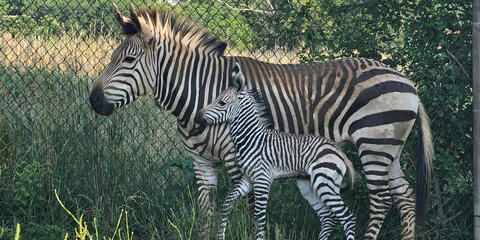Physical Description
The dama gazelle, also called the mhorr or addra gazelle, is the largest of the gazelles and was once common and widespread in arid and semi-arid regions of the Sahara. There are currently three recognized subspecies of Nanger Dama: N. dama ruficollis, N. dama dama, and N. dama mhorr. The Smithsonian's National Zoo exhibits N. dama ruficollis.
Nanger dama ruficollis, is the lightest in coloration and the most eastern subspecies of the three. Common names for this subspecies include Addra Gazelle, Kordofan Gazelle, and Nubian Red-necked Gazelle.
The upper part of their body is mostly reddish brown, whereas the head, rump and under parts are white.
Both males and females have horns. They curve back and up, but reach a length of only about 17 inches (43 centimeters) long. The male's horns have 18 to 23 distinct rings and smooth tips while the females are typically smaller, thinner and the rings less distinct.
Size
Dama gazelle stand about 39 inches (99 centimeters) tall at the shoulder and weigh around 88 to 190 pounds (40 to 86 kilograms).
Native Habitat
The dama gazelle's historical range included the desert and arid zones of Chad (eastern), and the Darfur and Kordofan Provinces of Sudan. Due to wars in their range, habitat destruction, desertification, overhunting, and human and livestock population expansion, they are now extremely rare, occurring only as vagrants or in pockets
Lifespan
The life span of the dama gazelle is unknown in the wild. In human care, individual males have lived up to 15 years and individual females have lived up to 19 years.
Food/Eating Habits
Dama gazelles obtain most of their water from the plants they consume. Their diet includes various desert shrubs and acacias, along with rough desert grasses.
At the Zoo, they eat orchard grass hay and alfalfa hay — about a flake each per day. In addition they eat roughly 2.5 pounds of herbivore pellet per day, with leaf eater biscuits and browse as treats.
Reproduction and Development
Much of what is known about reproduction comes from animal husbandry experience in human care. Males reach sexual maturity at around one year and females around one and half years. The gestation is approximately six and a half months, resulting in a single offspring. Twinning is very rare. In human care, births occur year round.
Reproductive scientists at the Zoo are conducting fecal hormone studies on dama gazelle at both the Zoo and Smithsonian's Conservation Biology Institute. They are working to gather baseline hormone data to determine onset of puberty and breeding patterns in both sexes, estrus cycle in females as well as gestation timing and duration. They are also studying gazelle semen and working to develop techniques for cryopreservation. The newest dama gazelle study that the Zoo is helping to lead is a partnership between the Zoo and the White Oak Conservation Center to determine the ideal timing for insemination.
Conservation Efforts
Dama gazelles are critically endangered, which means they face a very high risk of extinction in the wild. The wild population has dropped precipitously in the past 20 years, with a scant 400 estimated to remain in the wild.
Zoo scientists are working with dama gazelles both at the Zoo and in the field.
Help this Species
- Support organizations like the Smithsonian’s National Zoo and Conservation Biology Institute that research better ways to protect and care for this animal and other endangered species. Consider donating your time, money or goods.
- Share the story of this animal with others. Simply raising awareness about this species can contribute to its overall protection.
Meet the Animals
Female Dama gazelles named Adara, Fahima and Amaya live at Cheetah Conservation Station. They share an exhibit with Ruppell's griffon vultures and scimitar-horned oryx.



